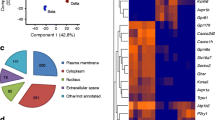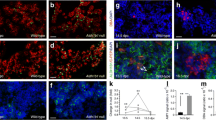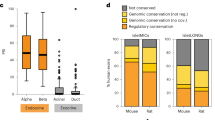Abstract
Background
Gene expression in islets of Langerhans is profoundly sensitive to glucose and other nutrients. Islets of Langerhans in the Anx7(+/−) knockout mouse exhibit a profound reduction in ITPR3 protein expression, defective intracellular calcium signaling, and defective insulin secretion. Additional data presented here also show that mRNA for ITPR3 is virtually undetectable in isolated Anx7(+/−) islets. IP3Receptor type 3 (ITPR3) expression in islets of Langerhans is closely regulated by secretory stimuli, and it has been suggested that the level of the ITPR3 expression controls the ability of the islets to respond to nutritional signals. We report that although control islets respond to glucose in vitro by a transient increment in ITPR3 mRNA, the islets from the Anx7(+/−) mouse remain low. We therefore hypothesized that the Anx7/IP3 Receptor(3)/Ca2+ signaling pathway plays a role in β cell responses to glucose, and that in the absence of the Anx7/ITPR3 signaling system, the islets would be unable to discriminate between fed or fasted states in vivo.
Materials and Methods
To test this hypothesis, we subjected Anx7(+/−) and control mice to either food and water ad libidum or to an overnight fast with access to water only. We then isolated the respective islets and compared nutrient-dependent changes in global gene expression under the four conditions using genome-based microarray technology.
Results
Anx7 protein expression in these islets is only about 50% of control levels in normal littermate controls, and IPTR3 message and protein are virtually zero. cDNA microarray analyses show that in control animals gene expression is significantly affected by the fasting state. Many of the affected genes have historical relevance to development and differentiation of islets. These include preproglucagon, APOJ, cadherin2, phosphoglucoisomerase, oncostatin M, PAX6, HGF, and cytokeratin 18. However, there are also many other nutritionally sensitive genes in control islets that are principally associated with cell division and DNA repair. The latter genes have not specifically been associated with islet physiology in the past. By contrast, Anx7(+/−) mouse islets exhibit a greatly reduced ability to discriminate genomically between fed and fasted states for all classes of identified genes. Many of the validated genes are specific to islets in comparison to liver tissue examined. Real-time quantitative RT-PCR analysis of islets from Anx7 heterozygous mice and littermate controls revealed remarkable down-regulation in PTEN, Glut-2, PDX-1, IGF-1, and Neuro D1 expression, but not in liver.
Conclusions
We conclude that reduced gene dosage in the Anx7(+/−) islet, with concomitant loss of ITPR3 expression and consequent defects in Ca2+ signaling, may substantially contribute to the mechanism of the loss of genomic discrimination, in vivo, between the fed and fasted states. We believe that the requirement for complete Anx7 gene dosage and IPTR3 expression in islets of Langerhans will prove to be of fundamental importance for understanding the mechanism of nutritional sensing in health and disease.




Similar content being viewed by others
References
Malaisse WJ. (1983) Insulin release: the fuel concept. Diabetes Metab. 4: 313–320.
O’Rahilly SO, Hosker JP, Rudenski AS, et al. (1988) The glucose stimulus-response curve of the beta-cell in physically trained humans, assessed by hyperglycemic clamps. Metabolism 10: 919–923.
Lang DA, Matthews DR, Peto J, Turner RC. (1979) Cyclic oscillations of basal plasma glucose and insulin concentrations in human beings. N. Engl. J. Med. 301: 1023–1027.
Pratley RE, Weyer C. (2001) Insulin resistance and insulin secretory dysfunction are independent predictors of worsening of glucose tolerance during each stage of type 2 diabetes development. Diabetic Care 1: 89–94.
Mears D, Atwater I. (2002) Electrophysiology of the pancreatic β-cell. In Leroith D, Taylor SI, Olefsky JM (eds). Philadelphia, PA (Lippincott Williams & Wilkins) Diabetes Mellitus. pp 47–61.
Ashcroft FM, Proks P, Smith PA, et al. (1994) Stimulus-secretion coupling in pancreatic beta cells. J. Cell Biochem. 55: 54–65.
Prentki M, Glennon MC, Geschwind JF, et al. (1987) Cyclic AMP raises cytosolic Ca2+ and promotes Ca2+ influx in a clonal pancreatic beta-cell line (HIT T-15). FEBS Lett. 220: 103–107.
Laybutt DR, Kaneto H, Hasnkamp W, et al. (2002) Increased expression of antioxidant and antiapoptotic genes in islets that may contribute to beta-cell survival during chronic hyperglycemia. Diabetes. 51: 413–423.
Herrera PL. (2002) Defining the cell lineages of the islets of Langerhans using transgenic mice. Int. J. Dev. Biol. 46: 97–103.
Hirschi KD, Kreps JA, Hirschi KK. (2001) Molecular approaches to studying nutrient metabolism and function: an array of possibilities. J. Nutr. 131: 1605S–1609S.
Cao SX, Dhahbi JM, Mote PL, Spindler SR. (2001) Genomic profiling of short- and long-term caloric restriction effects in the liver of aging mice. Proc. Natl. Acad. Sci. U.S.A. 98: 10630–10635.
Kita Y, Shiozawa M, Weihoong J, et al. (2002) Implications of circadian gene expression in kidney, liver and the effects of fasting on pharmacogenomic studies. Pharmacogenetics 12: 55–65.
Srivastava M, Eidelman O, Pollard HB. (1999) Pharmacogenomics of the cystic fibrosis transmembrane conductance regulator (CFTR), and of the cystic fibrosis drug CPX using genome microarray analysis. Mol. Med. 5: 753–767.
Eidelman O, Srivastava M, Zhang J, et al. (2001) Genes from the TNFaR/NFkB pathway control the pro-inflammatory state in cystic fibrosis epithelial cells. Mol. Med. 7: 523–534.
Gilon P, Shepherd RM, Henquin JC. (1993) Oscillations of secretion driven by oscillations of cytoplasmic Ca2+ as evidences in single pancreatic islets. J. Biol. Chem. 268: 22265–22268.
Lawrence MC, Bhatt HS, Watterson JM, Easom RA. (2001) Regulation of insulin gene transcription by a Ca(2+)-responsive pathway involving calcineurin and nuclear factor of activated T cells. Mol. Endocrinol. 10: 1758–1767.
Lee B, Gai W, Laychock SG. (2001) Proteosomal activation mediates down-regulation of inositiol trisphosphate receptor and calcium mobilization in rat pancreatic islets. Endocrinology 142: 1744–1751.
Lee B, Jonas JC, Weir GC, Laychock SG. (1999) Glucose regulates expression of inositol 1,4,5,-trisphosphate receptor isoforms in isolated rat pancreatic islets. Endocrinology 140: 2173–2182.
Lee B, Laychock SG. (2000) Regulation of inositiol trisphosphate receptor isoform expression in glucose-desensitized rat pancreatic islets: role of cyclic adenosine 3′, 5′-monophosphate and calcium. Endocrinology 141: 1394–1402.
Srivastava M, Atwater I, Glasman M, et al. (1999) Defects in IP3 receptors expression, Ca2+-signaling and insulin secretion in the anx7 (+/−) knockout mouse. Proc. Natl. Acad. Sci. U.S.A. 96: 13783–13788.
Goping G, Leapman R, Pollard HB, Srivastava M. (2002) Mapping protein expression in mouse pancreatic islets by immunolabeling and electron spectroscopic imaging. Microscopy Research and Techniques (In Press)
Boschero AC, Malaisse WJ. (1979) Stimulus-secretion coupling of glucose-induced insulin release. XXIX. Regulation of 86Rb+efflux from perfused islets. Am. J. Physiol. 236: E139–E146.
Butler M, McKay RA, Popoff IJ, et al. (2002) Specific inhibition of PTEN expression reverses hyperglycemia in diabetic mice. Diabetes 51: 1028–1034
Srivastava M, Kumar P, Leighton X, et al. (2002) Influence of the Anx7 (+/−) knockout mutation and fasting stress on the genomics of the mouse adrenal gland. Ann. N. Y. Acad. Sci. 971: 53–70.
Bonner-Weir S, Baxter LA, Schuppin GT, Smith FE. (1993) A second pathway for regeneration of adult exocrine and endocrine pancreas. A possible recapitulation of embryonic development. Diabetes 42: 1715–1720.
Boj S, Parrizas M, Maestro MA, Ferrer J. (2001) A transcription factor regulatory circuit in differentiated pancreatic cells. Proc. Natl. Acad. Sci. U.S.A. 98: 14481–14486.
Bouwens L, Wang RN, De Blay E, et al. (1994) Cytokeratins as markers of ductal cell differentiation and islet neogenesis in the neonatal rat pancreas. Diabetes 43: 1279–1283.
Steinert PM, Roop DR. (1988) Molecular and cellular biology of intermediate filaments. Annu. Rev. Biochem. 57: 593–625.
Kulesh DA, Oshima RG. (1988) Cloning of the human keratin 18 gene and its expression in nonepithelial mouse cells. Mol. Cell Biol. 8: 1540–1550.
Kobayashi T, Nakanishi K, Kajio H, et al. (1990) Pancreatic cytokeratin: an antigen of pancreatic exocrine cell autoantibodies in type 1 (insulin-dependent) diabetes mellitus. Diabetologia 33: 363–370.
Gradwohl G, Dierich A, LeMeur M, Guillemot F. (2000) Neurogenin3 is required for the development of the four endocrine cell lineages of the pancreas. Proc. Natl. Acad. Sci. U.S.A. 97: 1607–1611.
Yamaoka T, Itakura M. (1999) Development of pancreatic islets. Int. J. Mol. Med. 3: 247–261.
Beimar F, Argenton F, Schmidtke R, et al. (2001) Pancreas development in the zebrafish: early dispersed appearance of endocrine hormone expressing cells and their convergence to form the definitive islet. Dev. Biol. 230: 189–203.
Sander M, Neubuser A, Kalamaras J, et al. (1997) Genetic analysis reveals that PAX6 is required for normal transcription of pancreatic hormone genes and islet development. Genes Devel. 11: 1662–1673.
Hill ME, Asa SL, Drucker DJ. (1999) Essential requirement for Pax6 in control of enteroendocrine proglucagon gene transcription. Mol. Endocrinol. 13: 1474–1486.
St. Onge L, Sosa-Pineda B, Chowdhury K, et al. (1997) Pax6 is required for differentiation of glucagon-producing alpha cells in mouse pancreas. Nature 387: 406–409.
Yamaoka T, Yano M, Yamada T, et al. (2000) Diabetes and pancreatic tumours in transgenic mice expressing Pax6. Diabetologia 43: 332–339.
Shibata H, Kanzaki M, Takeuchi T, et al. (1996) Two distinct signaling pathways activated by activin A in glucose-responsive pancreatic beta-cell lines. J. Mol. Endocrinol. 16: 249–258.
Kojima I. (1997) Effect of activin A on the formation of pancreatic endocrine cells. In Aono T, Sugino H, Vale W (eds). Inhibin, Activin and Follistatin. Springer-Verlag, Berlin, Heidelberg, Vienna, and Milan; pp. 189–203.
Lefebvre VH, Otonkoski T, Ustinov J, et al. (1998) Culture of adult human islet preparations with hepatocyte growth factor and 804G matrix is mitogenic for duct cells but not for beta-cells. Diabetes 47: 134–137.
Garcia-Oceana A, Takane KK, Syed MA, et al. (2000) Hepatocyte growth factor overexpression in the islet of transgenic mice increases beta cell proliferation, enhances islet mass, and induces mild hypoglycemia. J. Biol. Chem. 275: 1226–1232.
Christofori G, Naik P, Hanahan D. (1995) Vascular endothelial growth factor and its receptors Flt-1 and flk-1 are expressed in normal pancreatic islets and throughout islet call tumorigenesis. Mol. Endocrinol. 9: 1760–1770.
Gorden DL, Mandriota SJ, Montesano R, et al. (1997) Vascular endothelial growth factor is increased in devascularized rat islets of Langerhans in vitro. Transplantation 63: 436–443.
Kuroda M, Oka T, Oka Y, et al. (1995) Colocalization of vascular endothelial growth factor (vascular permeability factor) and insulin in pancreatic islet cells. J. Clin. Endocrinol. Metab. 80: 3196–3200.
Oberg-Welsh C, Sandler S, Andersson A, Welsh M. (1997) Effects of vascular endothelial growth factor on pancreatic duct cell replication and the insulin production of fetal islet-like cell clusters in vitro. Mol. Cell Endocrinol. 126: 125–132.
Rooman I, Schuit F, Bouwens L. (1997) Effect of vascular endothelial growth factor on growth and differentiation of pancreatic ductal epithelium. Lab. Invest. 76: 225–232.
Adams RH, Diella F, Hennig S, et al. (2001) The cytoplasmic domain of the ligand ephrin B2 is required for vascular morphogenesis but not cranial neural crest migration. Cell 104: 57–69.
Hattori K, Dias S, Heissig B, et al. (2001) Vascular endothelial growth factor and angiopoietin-1 stimulate postnatal hematopoiesis by recruitment of vasculogenic and hematopoietic stem cells. J. Exp. Med. 193: 1005–1014.
Papapetropoulos A, Fulton D, Mahboubi K, et al. (2000) Angiopoietin-1 inhibits endothelial cell apoptosis via the Akt/survivin pathway. J. Biol. Chem. 275: 9102–9105.
Esni F, Taljedal IB, Perl AK, et al. (1999) Neural cell adhesion molecule (N-CAM) is required for cell type segregation and normal ultrastructure in pancreatic islets. J. Cell Biol. 144: 325–337.
Moller CJ, Christgau S, Williamson MR, et al. (1992) Differential expression of neural cell adhesion molecule and cadherins in pancreatic islets, glucagonomas and insulinomas. Mol. Endocrinol. 6: 1332–1342.
Larue L, Antos C, Butz S, et al. (1996) A role for cadherins in tissue formation. Development 122: 3185–3194.
Dahl U, Sjodin A, Semb H. (1996) Cadherins regulate aggregation of pancreatic beta cells in vivo. Development 122: 2895–2902.
Gaidar YA, Lepekhin EA, Sheichetova GA, Witt M. (1998) Distribution of N-cadherin and NCAM in neurons and endocrine cells of the human embryonic and fetal gastroenteropancreatic system. Acta Histochem. 100: 83–97.
Ortolan TG, Tongaonkar P, Lambertson D, et al. (2000) The DNA repair protein rad23 is a negative regulator of multiubiquitin chain assembly. Nat. Cell Biol. 2: 601–608.
McKay MJ, Troelstra C, van der Spek P, et al. (1996) Sequence conservation of the rad 21 Schizosacchararomyces pombe DNA double strand break repair gene in human and mouse. Genomics 36: 305–315.
Huang RP, Adamson ED. (1995) A role for Egr-1 in cell survival following ultraviolet irradiation. Oncogene 10: 467–475.
Lim CP, Jain N, Cao X. (1998) Stress-induced immediate early gene egr-1 involves activation of p38/JNK1. Oncogene 16: 2915–2926.
Blais S, Boudreau F, Beaulieu JF, Asselin C. (1995) CCAAT/enhancer binding protein isoforms expression in colon of neonatal mice. Dev. Dyn. 204: 66–76.
Seufert J, Weir GC, Habener JF. (1998) Differential expression of the insulin gene transcriptional repressor CCAAT/enhancer-binding protein beta and transactivator islet/duodenum homeobox-1 in rat pancreatic beta cells during the development of diabetes mellitus. J. Clin. Inv. 101: 2528–2539.
Zador IZ, Hsieh CC, Papaconstantinou J. (1998) Renal CCAAT/enhancer bonding proteins in experimental diabetes mellitus. Nephron 79: 312–316.
Hatada I, Nabetani A, Arai Y, et al. (1997) Aberrant methylation of an imprinted gene U2af1-rs1 (SP2) caused by its own transgene. J. Biol. Chem. 272: 9120–9122.
O’Bryan JP, Songyang Z, Cantley L, et al. (1996) A mammalian adapter protein with conserved src homology 2 and phosphotyrosine binding domains is related to Shc, and is specifically expressed in the brain. Proc. Natl. Acad. Sci. U.S.A. 93: 2729–2734.
Srivastava M, Bubendorf L, Nolan L, et al. (2001) ANX7, a candidate tumor-suppressor gene for prostate cancer. Proc. Natl. Acad. Sci. U.S.A. 98: 4575–4580.
Author information
Authors and Affiliations
Corresponding author
Rights and permissions
About this article
Cite this article
Srivastava, M., Eidelman, O., Leighton, X. et al. Anx7 Is Required for Nutritional Control of Gene Expression in Mouse Pancreatic Islets of Langerhans. Mol Med 8, 781–797 (2002). https://doi.org/10.1007/BF03402083
Accepted:
Published:
Issue Date:
DOI: https://doi.org/10.1007/BF03402083




